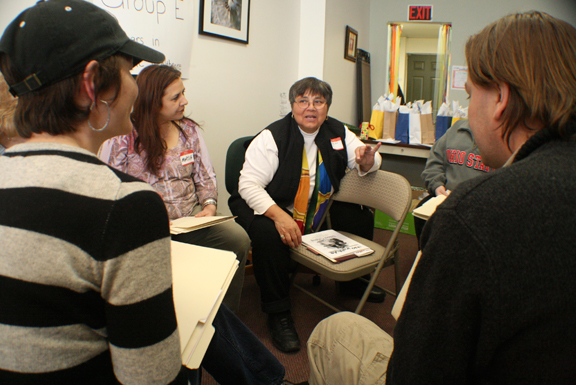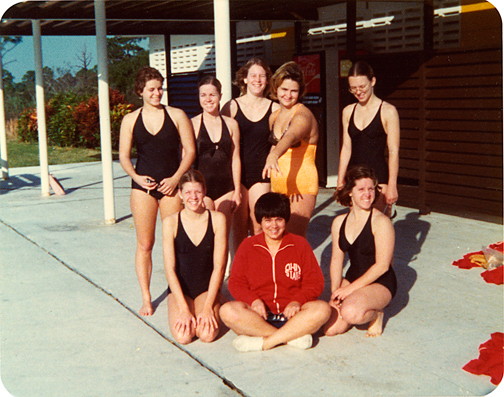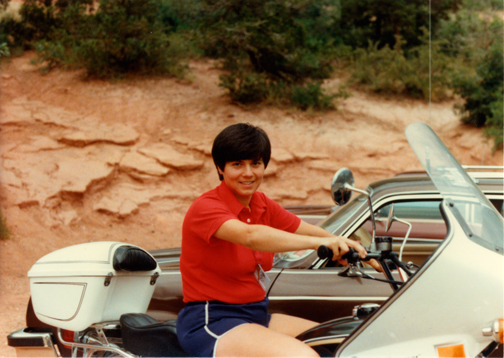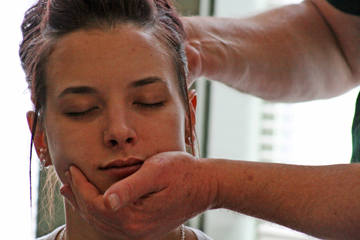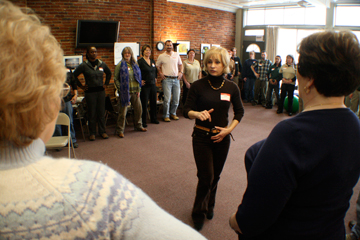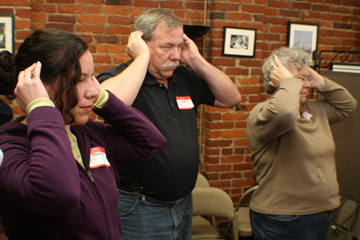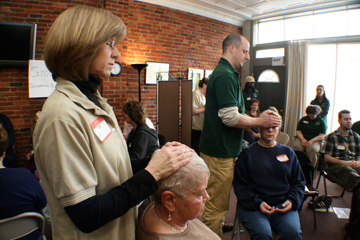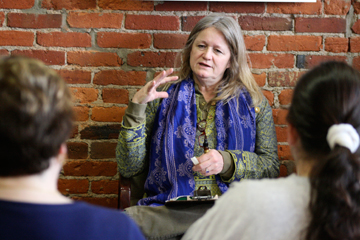
Columbus, Ohio USA
Return to Homepage www.shortnorth.com
To Your Health!
After coaching Olympic athletes,
Mary Jo Ruggieri is making a splash in holistic health care
By Jennifer Hambrick
jmhambrick@yahoo.com
April 2009 Issue
Return to Features Index Return to Homepage
At a recent Ohio Institute of Energetic Studies and Bodywork holistic healthcare expo,
institute founder Mary Jo Ruggieri shares information on some programs. The institute has trained about 800 Polarity therapy and energy practitioners. © Photo by William BullockMary Jo Ruggieri believes in getting healthy and staying healthy. As founder and director of the Columbus Polarity Center and the Ohio Institute of Energetic Studies and Bodywork, Ruggieri, 60, may have found her calling: to practice and teach about holistic (sometimes called “alternative” or “complementary) therapies. But her arrival at this point came after wave upon wave of self-transformation – from second-generation Italian-American taking her grandmother’s herbal home remedies, to self-described Kent State “hippie,” to athlete and Olympic gold medal-winning synchronized swimming coach. And with America’s health care needs expanding and health care budget shrinking, Ruggieri and the Columbus Polarity Center are now at the forefront of a field that may in the future play an increasingly large role in good health.
From the Old World
Ruggieri grew up in a close-knit Italian family in the close-knit Italian community of Ravenna, Ohio. Her grandparents had lived off the land in their native Italy. When they arrived in America they were poor, but they knew how to survive.
“Coming from Italy, they all had gardens,” Ruggieri said. “They actually grew grapes. They made their own wines. They made their own medicinal things. They made elderberry drinks. They grew chamomile and they made chamomile tea.”
She remembers gargling with peppermint and spearmint leaves to soothe a sore throat and drinking licorice tea to calm an upset stomach. She also remembers the warm milk with licorice honey that sometimes lulled her to sleep and the cookies flavored with her grandmother’s homegrown anise.
Ruggieri’s father, Angelo Ruggieri, played professional minor league baseball, first in New York and then in Ohio. Mary Jo Ruggieri remembers as a five-year-old playing catch with her father.
“My dad put a glove on me and he would sit there and pitch balls to me,” Ruggieri said. “He’d get to the point where he’d throw it hard enough where it stung my hand. And he’d say, ‘You know, you’ve gotta be tough.’”
Ruggieri also remembers serving as bat girl for her father’s home games. For about six years, until she was 12, she’d wait in the dugout until one of the players hit the ball, and then run out to the diamond to retrieve the dropped bat. The work wasn’t glamorous and it paid literally nothing, but it kept Mary Jo around sports.
As passionate as Angelo Ruggieri was about teaching his kids baseball, he absolutely insisted that Mary Jo learn to swim.
“His big thing was that I had to learn to swim when I was young. He brought me out to swim on the swim teams, so I grew into swimming,” Ruggieri said. And the good news was, she liked sports.
“Fortunately my mother was good with this, that I didn’t want to do all the girly-girly things,” Ruggieri said.
Ruggieri attended nearby Kent State University as an undergraduate. She was a student there during the Vietnam War and at the time of the notorious Kent State shootings and found a niche at Kent State in anti-war politics.
“I was really, really out of the box,” Ruggieri said. “I became a peace activist. And, of course, the Beatles were influential in those times with meditation and that stuff.”
She graduated from Kent State in 1973 with degrees in health sciences/physical education and speech and theater. Ruggieri got a job teaching in both of her undergraduate areas of study at Anderson High School, outside Cincinnati. She arrived at Anderson just as interest in girls’ sports was starting to flourish. Ruggieri had the background to coach and wanted to see girls get opportunities to play. So she started and coached many of the girls’ sports teams at Anderson, including field hockey, track, golf, and competitive swimming.
But she balked when Anderson’s principal asked her to start a synchronized swimming team. The parents of Anderson’s students had paid – with tax dollars – for a new pool. And the parents of some of the school’s female students were asking that their daughters have a chance to use it for synchronized swimming.
“I was a competitive swimmer, and I thought synchronized swimming was ridiculous,” Ruggieri said.
But she started the team. Ruggieri made up routines for the swimmers to practice and put the synchronized swimmers through the same conditioning regimen the competitive swimmers went through.
“I was looking at the physiology and mechanics of it,” Ruggieri said. “Synchronized swimming at that stage was not as athletic and I made it athletic.”
Eventually her synchronized swimming team started winning state championships. Ohio State University picked up on Ruggieri’s success and wanted its own synchronized swimming team to capture some of it.
“They (Ohio State) had a long-standing synchronized swimming team dating back to 1934,” Ruggieri said. “So when they wanted to move forward, they saw what I was doing, they noticed that my team did this very quickly, and they hired me to come in.”
In 1974 Ruggieri left Anderson High School and moved to Columbus to teach physical education and health science and to coach synchronized swimming at Ohio State. That year put Ruggieri on a trajectory that would cause her to revamp her approach to coaching and revolutionize synchronized swimming worldwide.The Whole Athlete
A photograph taken in 1976 of the first national championship team at OSU coached by Mary Jo Ruggieri (seated front center). At Ohio State, Ruggieri simultaneously developed her academic credentials and her coaching skills. In 1978 she completed a Ph.D. at the University of Cincinnati in a self-designed program in exercise physiology. But the same year saw disaster for the OSU synchronized swimming team. In preparing her athletes for the 1978 Pan American Games team trials, Ruggieri had relied on an extensive battery of physiological tests to gauge her athletes’ physical conditioning.
“It was all mechanical,” Ruggieri said. “I had a stopwatch and (calculated) how much speed they had and how much their heart rate recovered, and I did lactic acid uptake tests on them and I tried to increase their oxygen capacities.”
Even so, her team tanked in competition. Only one of her athletes made the U.S. Pan American Games team that year.
“I thought I had prepared the top team in the country and the top athletes and all of them fell apart, except one,” Ruggieri said.
Ruggieri knew her coaching had to go in a different direction. She signed up for a community yoga and meditation class through OSU and hoped that tapping more deeply into her instincts through these ancient practices might show her what to do next.
The instructor of that class was Guruka Singh Khalsa. Khalsa introduced Ruggieri to Yogi Bhajan, who ran the 3HO Foundation in Clintonville in the 1970s. Ruggieri started learning about Ayurvedic medicine from Yogi Bhajan and began adding Ayurvedic breath work, exercises and dietary practices to her yoga and meditation regimen.
For Ruggieri, it wasn’t an enormous leap from her mother’s Old World herbal remedies to the nature-based system of Ayurveda. Originating thousands of years ago in ancient India, Ayurveda holds that the body’s energies, grounded in the elements of nature, are the basis of health or disease. According to Ayurveda, if your energies flow in balance, then you are healthy. Blocked and unbalanced energies, however, are thought to be the cause of pain and disease. Physical and breathing exercises, a carefully regulated diet, natural remedies, reflexology and acupressure work to free and balance energy channels are believed by Ayurvedic practitioners to enhance health.
Ruggieri thought the physical and mental training she was putting herself through by adopting Ayurvedic practices might help her athletes.
“So here I was in the ’70s doing all this stuff and I realized it was an easy transfer for me to transfer from that into athletics,” Ruggieri said.
She continued to use traditional coaching techniques derived from Western medical science, but relied increasingly on non-Western therapies to train her athletes.
“My yoga teacher would come in every Wednesday, and whether rain or shine they would do an hour and a half of yoga,” Ruggieri said. “They’d go, ‘What’s this? I should be practicing.’ ‘No, you’re going to meditate, you’re going to do yoga.’”
Jessica Reid was a member of Ruggieri’s OSU and National synchronized swim teams between 1987 and 1990 and remembers wishing she were in the pool during the team’s weekly yoga classes.
“We had to go to an ashram up on north campus that was sort of a pain to get to on a Sunday afternoon,” Reid said. “And I was a young person not necessarily informed about the world, and skeptical: One more thing we have to do for our training. You hope that it’s improving your skill but somewhere back in your head you’re sort of thinking, I’d rather be back in the pool.”
Reid, who had numerous hip and shoulder injuries, says Ruggieri once took her to see a qigong practitioner. Ruggieri also took some of her athletes to acupuncturists, chiropractors, and massage therapists. It was an intense regimen that meant a lifestyle change for her team. It also still mostly focused on the physical, so Ruggieri enlisted the help of sports psychologists long before the coaching community had fully embraced that specialty.
“I realized that at this level of training, 360 days a year, six and eight hours a day, I had to use a psychologist,” Ruggieri said.
Mary Jo Ruggieri in 1980, a period when she ran the R & R Sports Academy in a number of locations around the country with former OSU tennis coach Mary Raysa. Nearly 20 years before Ohio State University hired its first full-time sports psychologist in 1995, Ruggieri had counselors work with her swimmers, to check their levels of anxiety and burn-out, to unpack issues in their lives beyond sports that could be affecting their performance in the pool. Today, sports psychologists are considered important if not essential to an elite athlete’s training. Current OSU synchronized swimming Head Coach Linda Lichter-Witter says Ruggieri’s application of sports psychology, as well as other non-traditional training methods, in the late ’70s and early ’80s was truly ahead of its time.
“Mary Jo was an incredible visionary,” Lichter-Witter said. “I cannot imagine what we would do with our collegiate athletes without sports psychology, with the pressures of school, family you name it.”
Before coming to swim for Ruggieri at Ohio State in the late 1980s, Tracy Moran had swum in Ruggieri’s swim camps of the R& R Sports Academy, a girls’ athletic camp company Ruggieri operated in a number of locations around the country between 1978 and 1992 with former OSU tennis coach Mary Raysa. At camp, Moran had experienced some of the holistic therapies Ruggieri used with her college athletes.
“We would have relaxation sessions at camp and massage therapy sessions on how to work on each other and ending together (as a group) in a circle,” Moran recalls of her camp days.
Moran knew she would get more of the same at Ohio State, and signed on because she thought Ruggieri was a great coach.
“I would say for Ohio State and for coaching she was definitely ahead of her time in trying to train the entire athlete, rather than just the physical endurance and sports-specific training,” Moran said. “Her comprehensive approach was probably more advanced than a lot of people were comfortable with. (But) we were a very high-productive team. We won a lot of national championships. We were producing as athletes and representing the university well and we were also being trained differently from a lot of other athletes. So many more athletes train more comprehensively than just their sports now.”
Ruggieri’s expanded approach to coaching led her swimmers to the Olympics in 1988 and 1992, where in Barcelona the U.S. team with former Ohio State athletes Karen and Sarah Josephson took the duet gold metal. She says her time coaching at Ohio State prepared her for what she does now.
“I realized within the 20 years of coaching at Ohio State that I could not create a good athlete without implementing a holistic approach,” Ruggieri said.Going for the Gold
A practitioner gives Katie Sagstetter a Polarity Therapy "head hold."
© Photo by William BullockRuggieri remembers the day when she realized she needed to take holistic health maintenance beyond the world of athletics. In 1995, she and former OSU women’s basketball coach Nancy Darsch had been invited to speak before a group of cancer survivors at the Arthur G. James Cancer Hospital. Ruggieri says she had planned to give an inspiring speech telling the patients to “go for the gold,” but as a James Hospital administrator made his introductory remarks, Ruggieri looked out at a sea of cancer survivors numbering into the thousands. Turbans and hats sat on heads stripped bald by chemotherapy. I.V. drip tubes dangled from wheelchairs.
“Right then and there, I got up to the mic and I ripped up my speech and I talked from my heart,” Ruggieri recalled. “Whether you’re fighting cancer, whether you’re fighting to win the gold medal at the Olympics, it was the same thing. I said, ‘I am here to motivate you and to tell you how to go for the gold. What can I tell you that you don’t already know? You are living this, you are going for the gold.’ I was in tears, and I said, ‘You are teaching us what to do.’”
Ruggieri had learned that treating her athletes with a variety of holistic therapies was an effective way to develop physically and mentally strong people. Wouldn’t it be nice, she wondered, if everyone could manage his own health care with help from a team of practitioners?
“When I looked at the 20-some years I had given these athletes, they had acupuncture, they were stretched by the ballet people. It was an unbelievable program. And yet they were healthy. And I thought, now, if you had cancer and you had that kind of a group, team approach. . . . So then I just went full focus into looking at the whole concept of integrative medicine, complementary therapies,” Ruggieri said.
Ruggieri took early retirement from Ohio State not long after giving that talk at the James and embarked on a study of alternative therapies and holistic health care. Polarity Therapy was an obvious choice for her. Based in Ayurveda, Polarity Therapy encompasses a number of alternative therapies that help free and balance the body’s energies. In the early twentieth century, the Austrian-born osteopath, naturopath and chiropractor Randolph Stone came to criticize these fields because of what he perceived as their emphasis on the gross physical body at the expense of its more subtle underlying energetic system. Stone believed that the root causes of the ailments commonly treated physically were imbalances in the body’s energy “currents” that, in his theory, run throughout the body between negative and positive poles. He looked to Ayurveda to find remedies, exercises, nutritional counseling and bodywork that could restore the flow and balance of the body’s energies. A Polarity Therapy practitioner might use gentle energy-balancing techniques, hold fingers lightly on energy points, and/or recommend yoga exercises, herbal remedies and/or meditation relaxation to help restore a client’s balance of energies.
By 1993, Ruggieri had transformed the office space on 5th Avenue in which she and Raysa had run R & R Sports Academy into her first Polarity Therapy practice, Ruggieri and Associates. In 1994 Ruggieri founded the Ohio Institute for Energetic Studies and Bodywork (OIESB) as a training school for Polarity Therapy practitioners. The school is registered with the Ohio State Board of Career Colleges and Schools. The institute has trained about 800 Polarity Therapy and energy practitioners.
Many people have found their way to the OIESB through their own struggles with pain or other health problems Western medicine hasn’t been able to solve. Some come to the institute just became they’re interested in learning about natural ways to stay healthy. Like Ruggieri, Letitia Bunge, an OIESB student and the Columbus Polarity Center’s office manager, was used to seeking out natural remedies for her aches and pains.
“I’ve never really wanted to take that much medicine. When I was growing up we would use ginger and honey for sore throats” Bunge said.
Bunge had had moderate success taking prescription medications for her sinuses. But since she began cleaning her sinuses every couple of weeks with a neti pot – a holistic remedy she learned about at the Columbus Polarity Center – she hasn’t needed the sinus medication.
Still, as committed to natural healing as Ruggieri is, she says Western medicine is the only treatment approach for many conditions and illnesses.
“If someone has a finger off and maybe needs a good person to stitch it back on, I’m not going to meditate,” Ruggieri says, “I’m going to get them to a good plastic surgeon.”
Ruggieri frequently partners with Western medical doctors. For more than five years, the Ohio State University Medical Center has allowed its fourth-year medical students to serve an elective rotation at the Columbus Center for Integrative Health and Wellness. Dr. Mary Jo Welker, chair of Family Medicine at OSU Medical School, says it’s important for aspiring Western physicians to know about holistic therapies, especially Polarity Therapy, which embraces so many holistic treatment modalities.
“So many of our patients are using them,” Welker said. “And part of any history-taking, especially when patients are taken to the hospital, is not just are you taking prescription medications, but what over-the-counter biologicals or herbals (are you taking).”
Welker says that some over-the-counter herbals remedies can interfere with prescription blood thinners like warfarin sodium (manufactured under the brand name Coumadin, among others) and certain HIV medications. And just as Ruggieri knows holistic treatments are not good options for many conditions, Welker says these treatments can sometimes help patients when Western medicine reaches the limit of its powers.
“I think in many times Western medicine fails,” Welker said. “Pain is one of those things where Western medicine doesn’t have a great solution a lot of times. We can do our x-rays and say, ‘You have arthritis in your back. I don’t really have a cure for you.’ So people turn to other mechanisms.”
The future of health care in America may well involve holistic therapies for more and more people. At least that’s what Ruggieri thinks will happen. She views holistic health care as a recession-proof industry within a broader health care market that is expected to expand in coming decades. In short, Ruggieri says the time for holistic health care has come, and that learning about holistic health care can empower people to be advocates for their own good health.
“I feel that we can teach people how to take care and take charge,” Ruggieri said. “We feel we empower people, and the holistic health care movement is a quality of life issue.”To learn more about the Ohio Institute of Energetic Studies and Bodywork, visit www.ohioinstitute.com or call 614-299-9438. The Columbus Polarity Center for Integrative Health & Wellness Web site is www.columbuspolarity.com
Left: Irina Tratintseva showing exercises. Right: (LtoR) Michelle, John, and Peggy Hickman doing temporal rub during exercises.
© All photos taken by William Bullock on February 28, 2009, at the Ohio Institute of Energetic Studies & Bodywork Holistic Healthcare Expo
held at the Columbus Polarity School, 1253 N. High St. in Columbus, Ohio.
Left: Practitioners Jill Jones and Ray Newsom doing polarity on clients. Right: Gloria Savage-O'Neil, Total Sensory Integration instructor Return to Homepage www.shortnorth.com
© 2009 Short North Gazette, Columbus, Ohio. All rights reserved.
